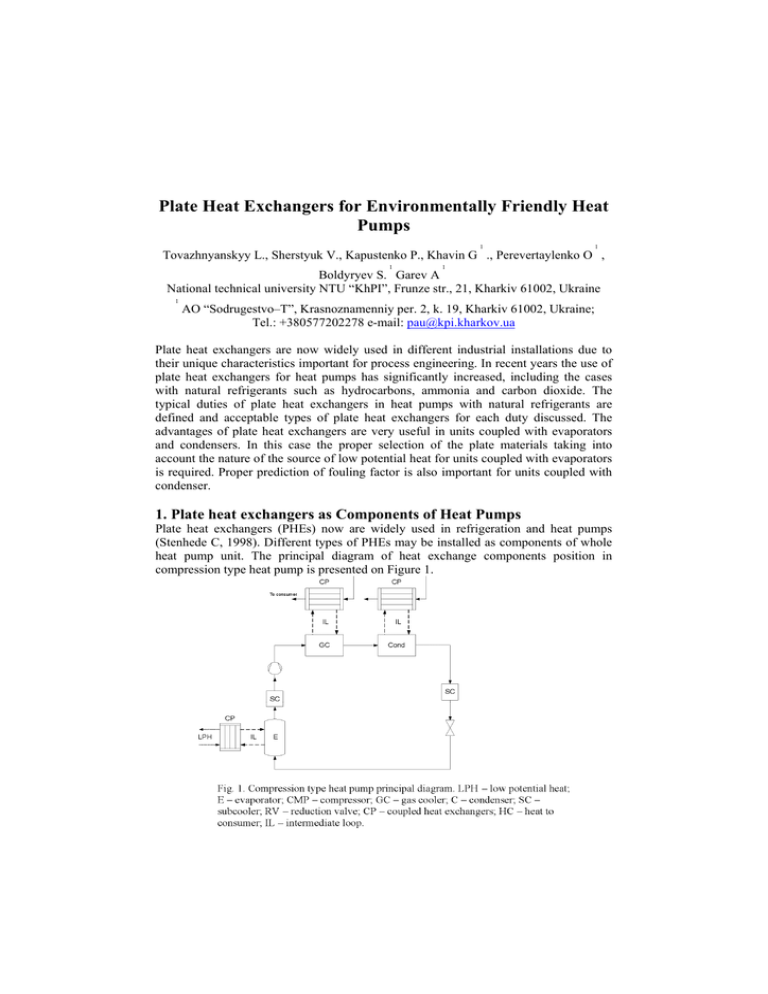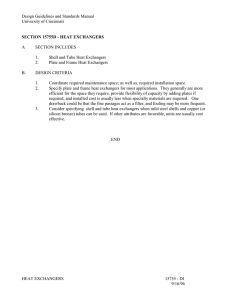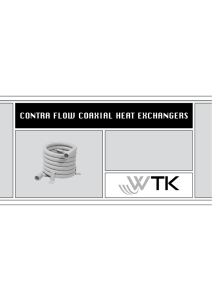Plate Heat Exchangers for Environmentally Friendly Heat Pumps
advertisement

Plate Heat Exchangers for Environmentally Friendly Heat Pumps 1 1 Tovazhnyanskyy L., Sherstyuk V., Kapustenko P., Khavin G ., Perevertaylenko O , 1 1 Boldyryev S. Garev A National technical university NTU “KhPI”, Frunze str., 21, Kharkiv 61002, Ukraine 1 AO “Sodrugestvo–T”, Krasnoznamenniy per. 2, k. 19, Kharkiv 61002, Ukraine; Tel.: +380577202278 e-mail: pau@kpi.kharkov.ua Plate heat exchangers are now widely used in different industrial installations due to their unique characteristics important for process engineering. In recent years the use of plate heat exchangers for heat pumps has significantly increased, including the cases with natural refrigerants such as hydrocarbons, ammonia and carbon dioxide. The typical duties of plate heat exchangers in heat pumps with natural refrigerants are defined and acceptable types of plate heat exchangers for each duty discussed. The advantages of plate heat exchangers are very useful in units coupled with evaporators and condensers. In this case the proper selection of the plate materials taking into account the nature of the source of low potential heat for units coupled with evaporators is required. Proper prediction of fouling factor is also important for units coupled with condenser. 1. Plate heat exchangers as Components of Heat Pumps Plate heat exchangers (PHEs) now are widely used in refrigeration and heat pumps (Stenhede C, 1998). Different types of PHEs may be installed as components of whole heat pump unit. The principal diagram of heat exchange components position in compression type heat pump is presented on Figure 1. The main loop of the heat pumps is the refrigerant loop. There are five heat exchange positions along this loop: evaporator, superheater, gas cooler or desuperheater of compressed gaseous refrigerant, condenser and subcooler of condensed refrigerant. Depending on nature and properties of refrigerants and heat pump construction the number of heat exchange components may be decreased, i.e. the main loop of the heat pump may be simplified. If we use the denotations of figure 1, we may describe such simplification as follows: Evaporation unit = E + SH (1) Condensation Unit = GC + C + SC (2) or Condensation unit = C + SC. (3) In other words it means the combination of the two phase heat transfer and single phase heat transfer from refrigerant flow in one heat exchanger unit. The results of the number of research works (Tovazhnyanskyy and Kapustenko, 1984; Thonon and Bontemps, 2002; Tovazhnyanskyy et al., 2002; 2004 etc) proved the significant enhancement of heat transfer in the patterns of modern PHEs both for single phase heat transfer and for vapor condensation and flow boiling processes comparatively with tubular heat exchangers. PHEs have following main advantages: - the high heat transfer efficiency lets reach minimal temperature difference between inlet of one stream and outlet of another and vice versa; - PHEs have small hold up volumes and are very compact. The second advantage is very important for heat pump main loop heat exchangers because it is possible to decrease the amount of refrigerant if PHEs are installed. The first advantage is significant when the intermediate heat exchangers coupled with main components of heat pump are used on reasons of safety and/or optimal design. All types of PHEs presented below may be used in heat pumps. 1.1. Gasketed PHEs Gasketed PHE consist of a pack of thin corrugated plates assembled on frame which include frame and pressure plates, carrying bars and tightening bolts (Fig.1). Each plate has the sealing gasket that is placed in appropriate grooves to form the channel for media flow from inlet collector hole to outlet one. Gasketed PHE let the inspection and mechanical cleaning of each side. It may consist of separate plates or of laser welded pairs of plates that have gaskets between, so only one side can be fully opened. Another type of plate and frame heat exchangers mentioned above is named as twinplates or semi-welded. This construction lets to reduce the possibility of leakages but increases the demands for quality of one of the streams. The inspection and mechanical cleaning are available only for one side that can be fully opened. The working temperature range of such units is from -50°C to 170°C depending on gaskets materials and working pressure is from vacuum up to 25 bars depending on frame type. 1.2. Brazed and welded PHEs The construction of brazed and welded PHEs makes the inspection and mechanical cleaning impossible, but such PHEs have wider temperature and pressure working ranges. Only chemical cleaning of both sides is possible so appropriate demands to quality of both fluids are required. Brazed PHEs. All components of brazed units (corrugated plates and end plates) are made on stainless steel and brazed in vacuum with 100% copper or nickel filler material. They are 100% stainless steel units that are made by fusion. It is Alfa Nova plate heat exchangers. The working temperatures and pressures for brazed PHEs are presented in table 1. Table 1. Working parameters of brazed PHEs. Temperature, °C Brazed PHE min max Pressure, MPa Copper Brazed -160 +225 2.5 Nickel Brazed -50 +225 1.6 Alfa Nova -50 +225 2.3 Note: 1. For nickel brazed units maximal temperature may be as high as 400°C for pressure 1.2 MPa. 2. For Alfa Nova units maximum pressure can reach 2.8 MPa for temperature 100°C. Welded PHEs. Welded PHEs have a wider range of working pressures and temperatures. The maximum working pressure is 35-40 bar. For special welded constructions in high pressure shell or envelope the working pressure may be as high as 320 bars. The maximum temperature for standard units is 350°C, for special welded designs it reaches 500-525°C. 2. Plate heat exchangers for natural refrigerants handling The use of different types of PHEs for duties in heat pumps with natural refrigerants is presented in table 2. Table 2. Different types of PHEs for duties in heat pumps with natural refrigerants HC Ammonia CO2 Plate and Frame Coupled Coupled Coupled gasketed Twin plates Evaporators Evaporators., gascoolers; Coupled (one side Condensers Condensers, superheaters., clean) coupled (one side clean) Copper brazed Evaporators NO NO Condensers Superheater Nickel brazed Evaporators Condensers Superheater Evaporators Condensers Superheater NO AlfaNova Evaporators Condensers Superheater Evaporators Condensers Superheater NO Welded All positions All positions NO Special welded in HP envelope All positions All positions All positions For brazed and welded types of PHEs the clean fluids should be used. If secondary fluid has potential fouling possibility and chemical cleaning gives little effect the coupling should be used. 3. The fouling in plate heat exchangers The fouling phenomenon on heat transfer surfaces reduces the efficiency of heat exchangers. For industrial units mechanical or/and chemical cleaning is often required. For heat pump applications the main fouling is taking place on water side as it is the most commonly used media for discharging heat from condenser or to supply heat to evaporator. In water fouling an accumulation of scale forming salts (CaCO3, CaSO4) occurs. For proper design of heat exchangers for water heating some assumption for fouling prediction should be done. In addition to factors like velocity, heat flux and wall temperature some chemical parameters of heated water should be considered. The pH value of the water has a significant influence on fouling behavior. For pH values above 6 aqueous solutions of CaCO3 show increase of the fouling accumulation, because solubility of carbonates decreases and the tendency to form scale becoming more intensive. Scale deposits vary in their structure, from a loose easily washable layer to a tenacious well adhering layer. The effect of the presence of calcium carbonate and calcium sulphate may form a deposit where precipitated calcium carbonate is acting as bonding cement enhancing the tenacity of the calcium sulfate deposit and its adherence to the heat transfer surface. For plate heat exchangers used in heat pumps as condensers or units for coupling with condensers the considerations aimed for fouling reduction may be as follows: - use of optimal flow rates (the relatively high shear stresses); - estimation of fouling thresholds (pH, Langlier index). 4. Case study for PHE as ammonia gas cooler The importance of ammonia as refrigerant in food refrigeration applications is well known (Korfitsen and Kristensen, 1998, Panno et.al., 2005). An on-site testing of heat substation for process water heating by superheated ammonia based on semi welded PHE was developed. This substation was installed at a modernized refrigerant unit of cheese factory in Ukraine. The flowsheet of pilot heat substation module and its performance parameters are presented on Figure 2. Superheated after compression, ammonia gas enters PHE and is cooled there by water of hot water circuit and then goes to main condensers of refrigeration unit. The heated water is used for needs of the factory. Technical characteristics of M10-BWFDR PHE: Number of plates: 36 (with possible increase to 56 plates) Number of passes : for ammonia side – 1; for water side – 1; Material of plates: Stainless steel AISI 316 Plate thickness 0.6 mm Hold-up volume: ammonia side 11.3 l; water side 10,7 l. Overall heat transfer coefficient (gas/liquid) – 837,2 W/(m2 K) Weight: 405 kg 5. Conclusions The installations of different types of plate heat exchangers in heat pumps with ozonelayer friendly natural refrigerants were discussed. The advantages of plate heat exchangers for such heat pumps are underlined. The on site tests of semi welded PHE have confirmed its good working parameters in such type of application. Controller Sodru Inlet ammonia (gas) T P T P To hot water storage tank TE M10-BWFDR 114 0C 60 0C 6220 kg/h Outlet ammonia (gas) 28 0C T 7406 kg/h P T P P Water from well 14 0C Fig. 2. Flow sheet of pilot heat substation module Acknowledgements The support by EC project SHERHPA (contract No COLL-CT-2004-500229) is sincerely acknowledged. References Stenhade C. A technical reference manual for plate heat exchangers in refrigeration and air conditioning applications. – Sweden, Lund, Alfa Laval Thermal, 3d edition, 1998, 162 pp. Tovaznyanskyy L.L., Kapustenko P.A. Intensification of heat and mass transfer in channels of plate condensers. "Chem. Eng. Commun.", 1984, v. 31, 6, p. 351-366. Thonon B., Bontemps A. Condensation of pure and mixture of hydrocarbos in a compact heat exchanger: experiments and modeling. "Heat transfer Engineering", 2002, v. 23, 6, p. 3-17. Tovaznyanskyy L.L., Kapustenko P.A., Perevertaylenko O. The investigation of flow boiling for flows in channels with cross-corrugated walls. "Heat transfer engineering", 2002, v. 23, 6, p. 62-69. Tovaznyanskyy L.L., Kapustenko P.A., Nagorna O.G., Perevertaylenko O. Yu. The simulation of multicomponent mixture condensation in plate condensers. "Heat transfer engineering", 2004, v. 25, 5, p. 16-22. Korfitsen E., Kristensen A.P.R. Ammonia high preasure heat pumps in food refrigeration applications. International Journal of Refrigeration, 1998, v.21, No3, pp212 – 218. Panno G., Auguanno S., Messineo A., Panno D. Ammonia heat pump for energy saving in food industrial processes: the case of cheese factory. IIR Conference: Ammonia Refrigerating Systems, Renewal and Improvement, Ohrid, 2005.




